WASHINGTON, D.C. -- The U.S. Payroll to Population employment rate (P2P), as measured by Gallup, was flat in July at 44.7%, unchanged from 44.8% in June 2013 and similar to the 45.0% in July 2012. July's P2P rate is also similar to the 44.9% rate in July 2011.
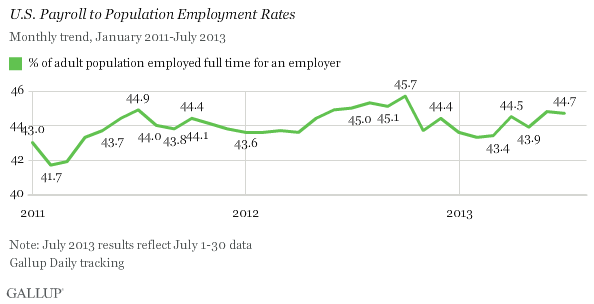
Gallup's P2P metric is an estimate of the percentage of the U.S. adult population aged 18 and older that is employed full time by an employer for at least 30 hours per week. P2P is not seasonally adjusted.
Payroll to Population historically tends to trend upward during the summer months and begins to decline again in the fall. That P2P is highest in June and July so far this year is to a certain degree to be expected due to this seasonality. Because of this, comparing year-over-year changes is helpful in evaluating whether monthly changes are due to seasonality or true growth (or decline) in the percentage of people working full time for an employer.
The fact that P2P has been seen so little change in July of the past three years indicates that the percentage of people working full time for an employer in July 2013 is similar to those found in July 2012 and July 2011.
These results are based on Gallup Daily tracking interviews with approximately 28,000 Americans conducted July 1-30 by landline and cellphone. Gallup does not count adults who are self-employed, working part time, unemployed, or out of the workforce as payroll-employed in the P2P metric.
Unlike Gallup's P2P rate, which is a percentage of the total U.S. population, traditional employment metrics, such as the unemployment rates Gallup and the U.S. Bureau of Labor Statistics report, are based on the percentage of the U.S. workforce. Gallup defines the "workforce" as adults who are working or are actively looking for work and available for employment. The U.S. workforce participation rate in July was 67.7%, down from 68.5% in June, but little changed from 67.6% in July 2012.
Gallup's unadjusted unemployment rate for the U.S. workforce is 7.8% in July, unchanged from June (7.8%), but down from 8.2% in July 2012.
Gallup's seasonally adjusted U.S. unemployment rate for July is 7.4%, a slight decline from 7.6% in June. Gallup calculates a seasonally adjusted employment rate by applying the adjustment factor the government used for the same month in the previous year. Last year, the government adjusted July's rate down by 0.4 percentage points, but adjusted June's down by 0.2 points, which accounts for the July decline in Gallup's adjusted rate, despite the lack of change in its unadjusted number.

Underemployment, as measured without seasonal adjustment, was 17.3% in July, essentially unchanged from 17.2% in June 2013 and 17.1% in July of last year.
Gallup's U.S. underemployment rate combines the percentage of adults in the workforce who are unemployed with the percentage working part time but looking for full-time work.
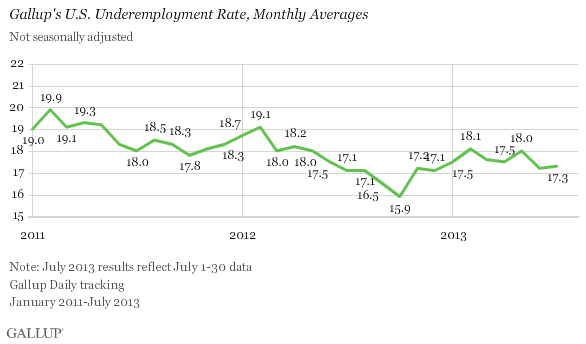
The percentage of part-time workers who want full-time work was 9.4% in July, the same as in June, but up from 8.9% in July 2012.
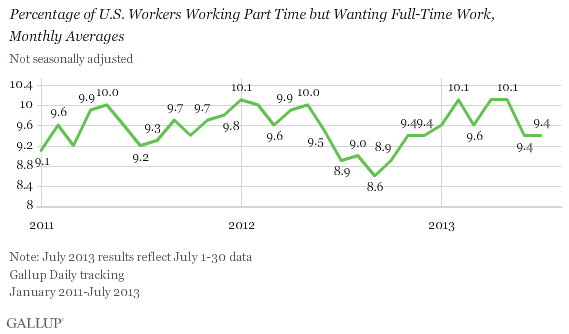
Bottom Line
Gallup's seasonally adjusted U.S. unemployment rate -- the closest comparison it has to the official numbers released by the BLS -- improved slightly in July. The BLS may report a decline in the unemployment rate when it releases its data Friday morning, even though Gallup's unadjusted number shows little month-over-month improvement. However, Gallup's adjusted number is based on past BLS seasonal adjustments, and July's adjustments may not be the same. Therefore, the unemployment rate as reported by the BLS each month does not always track precisely with the Gallup estimate.
A broader measure of the nation's employment situation is Gallup's P2P employment rate, which shows basically no growth in full-time jobs in the U.S. since 2011. There has been some growth in part-time jobs this year vs. last, but this means there are more Americans working part-time jobs who actually want full-time positions. Additionally, Gallup finds that fewer young adults are now working full time than were in the previous three years. Until and unless P2P comes back in a robust way, the economic recovery may continue to be slow.
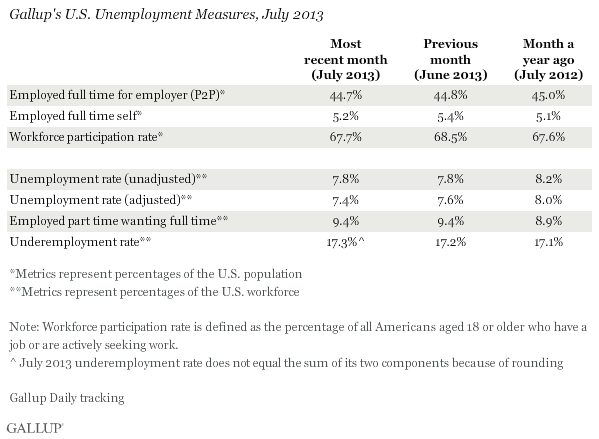
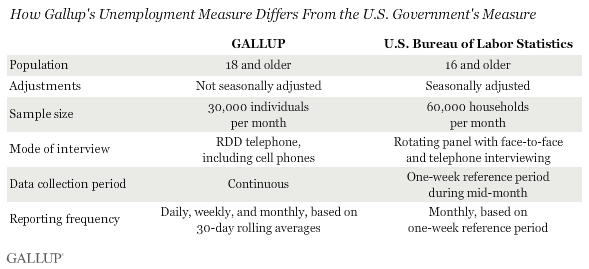
Gallup.com reports results from these indexes in daily, weekly, and monthly averages and in Gallup.com stories. Complete trend data are always available to view and export in the following charts:
Daily: Employment, Economic Confidence, Job Creation, Consumer Spending
Weekly: Employment, Economic Confidence, Job Creation, Consumer Spending
Read more about Gallup's economic measures.
View our economic release schedule.
Survey Methods
Results for this Gallup poll are based on telephone interviews conducted July 1-30, 2013, on the Gallup Daily tracking survey, with a random sample of 28,423 adults, aged 18 and older, living in all 50 U.S. states and the District of Columbia.
For results based on the total sample of national adults, one can say with 95% confidence that the margin of sampling error is ±1 percentage point.
Interviews are conducted with respondents on landline telephones and cellular phones, with interviews conducted in Spanish for respondents who are primarily Spanish-speaking. Each sample of national adults includes a minimum quota of 50% cellphone respondents and 50% landline respondents, with additional minimum quotas by region. Landline and cell telephone numbers are selected using random-digit-dial methods. Landline respondents are chosen at random within each household on the basis of which member had the most recent birthday.
Samples are weighted to correct for unequal selection probability, nonresponse, and double coverage of landline and cell users in the two sampling frames. They are also weighted to match the national demographics of gender, age, race, Hispanic ethnicity, education, region, population density, and phone status (cellphone only/landline only/both, and cellphone mostly). Demographic weighting targets are based on the March 2012 Current Population Survey figures for the aged 18 and older U.S. population. Phone status targets are based on the July-December 2011 National Health Interview Survey. Population density targets are based on the 2010 census. All reported margins of sampling error include the computed design effects for weighting.
In addition to sampling error, question wording and practical difficulties in conducting surveys can introduce error or bias into the findings of public opinion polls.
For more details on Gallup's polling methodology, visit www.gallup.com.
